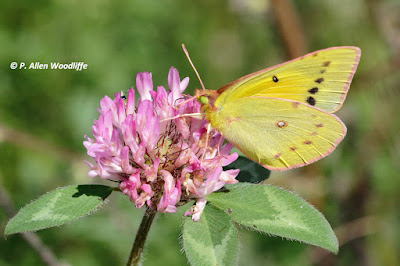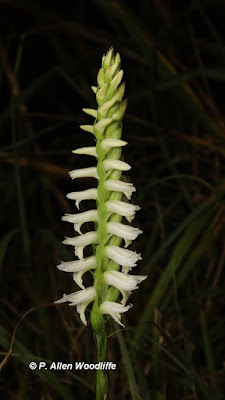Cabbage Whites continue to be super abundant. Clouded Sulphur and Orange Sulphur are also fairly abundant.
 |
| Cabbage White |
 |
| Clouded Sulphur |
 |
| Orange Sulphur |
An occasional Red Admiral, here sipping nectar on a Spotted Joe-pye-weed, may still be around.
 |
| Red Admiral |
Monarchs are on the move, heading southwest towards their overwintering site in the Mexican highlands..
Common Checkered-Skippers, those diminutive and attractive little later season visitors, are still around. Some of the later blooming asters are good spots to check for them.
 |
| Common Checkered-Skipper |
While the dominant colour of flowering plants in early autumn is the yellow of various goldenrod species, there are a few others tucked away. Surprisingly this Gray-headed Coneflower (Ratibida pinnata) was seen in good flower recently.
One that does not occur very commonly anywhere in Ontario is Biennial Gaura (Gaura biennis). It blooms early on a sunny day, and typically closes up by late morning.
A relatively rare autumn orchid is Great Plain's Ladies'-tresses (Spiranthes magnicamporum) occurs. There are several Spiranthes in the area in the late summer and early autumn, but even though this is S3 and therefore ranked as reasonably rare, it is by far the most common Spiranthes located here at this time of year here in the southwest.
Not restricted to prairies by any means, is this Pokeweed (Phytolacca americana). It has attractive white flowers that develop into succulent looking bluish-purple berries. Birds love them! But don't you try eating them....all parts of the plant are quite toxic to humans and other mammals.
This next species, the brilliant Cardinal Flower (Lobelia cardinalis), normally is in flower in early to mid-August. For some reason this one decided to extend the season.
If you have been paying attention to non-raptors passing by the various hawk watches in southern Ontario recently, you may have noticed tens of thousands of Blue Jays passing by, heading southwest. Are they all heading to Texas in support of their American League namesake???
Go Blue Jays!!!!










No comments:
Post a Comment